Zhi Quan
Transferable Deployment of Semantic Edge Inference Systems via Unsupervised Domain Adaption
Apr 16, 2025Abstract:This paper investigates deploying semantic edge inference systems for performing a common image clarification task. In particular, each system consists of multiple Internet of Things (IoT) devices that first locally encode the sensing data into semantic features and then transmit them to an edge server for subsequent data fusion and task inference. The inference accuracy is determined by efficient training of the feature encoder/decoder using labeled data samples. Due to the difference in sensing data and communication channel distributions, deploying the system in a new environment may induce high costs in annotating data labels and re-training the encoder/decoder models. To achieve cost-effective transferable system deployment, we propose an efficient Domain Adaptation method for Semantic Edge INference systems (DASEIN) that can maintain high inference accuracy in a new environment without the need for labeled samples. Specifically, DASEIN exploits the task-relevant data correlation between different deployment scenarios by leveraging the techniques of unsupervised domain adaptation and knowledge distillation. It devises an efficient two-step adaptation procedure that sequentially aligns the data distributions and adapts to the channel variations. Numerical results show that, under a substantial change in sensing data distributions, the proposed DASEIN outperforms the best-performing benchmark method by 7.09% and 21.33% in inference accuracy when the new environment has similar or 25 dB lower channel signal to noise power ratios (SNRs), respectively. This verifies the effectiveness of the proposed method in adapting both data and channel distributions in practical transfer deployment applications.
Scalable Multi-task Edge Sensing via Task-oriented Joint Information Gathering and Broadcast
Apr 16, 2025Abstract:The recent advance of edge computing technology enables significant sensing performance improvement of Internet of Things (IoT) networks. In particular, an edge server (ES) is responsible for gathering sensing data from distributed sensing devices, and immediately executing different sensing tasks to accommodate the heterogeneous service demands of mobile users. However, as the number of users surges and the sensing tasks become increasingly compute-intensive, the huge amount of computation workloads and data transmissions may overwhelm the edge system of limited resources. Accordingly, we propose in this paper a scalable edge sensing framework for multi-task execution, in the sense that the computation workload and communication overhead of the ES do not increase with the number of downstream users or tasks. By exploiting the task-relevant correlations, the proposed scheme implements a unified encoder at the ES, which produces a common low-dimensional message from the sensing data and broadcasts it to all users to execute their individual tasks. To achieve high sensing accuracy, we extend the well-known information bottleneck theory to a multi-task scenario to jointly optimize the information gathering and broadcast processes. We also develop an efficient two-step training procedure to optimize the parameters of the neural network-based codecs deployed in the edge sensing system. Experiment results show that the proposed scheme significantly outperforms the considered representative benchmark methods in multi-task inference accuracy. Besides, the proposed scheme is scalable to the network size, which maintains almost constant computation delay with less than 1% degradation of inference performance when the user number increases by four times.
DASECount: Domain-Agnostic Sample-Efficient Wireless Indoor Crowd Counting via Few-shot Learning
Nov 18, 2022



Abstract:Accurate indoor crowd counting (ICC) is a key enabler to many smart home/office applications. In this paper, we propose a Domain-Agnostic and Sample-Efficient wireless indoor crowd Counting (DASECount) framework that suffices to attain robust cross-domain detection accuracy given very limited data samples in new domains. DASECount leverages the wisdom of few-shot learning (FSL) paradigm consisting of two major stages: source domain meta training and target domain meta testing. Specifically, in the meta-training stage, we design and train two separate convolutional neural network (CNN) modules on the source domain dataset to fully capture the implicit amplitude and phase features of CSI measurements related to human activities. A subsequent knowledge distillation procedure is designed to iteratively update the CNN parameters for better generalization performance. In the meta-testing stage, we use the partial CNN modules to extract low-dimension features out of the high-dimension input target domain CSI data. With the obtained low-dimension CSI features, we can even use very few shots of target domain data samples (e.g., 5-shot samples) to train a lightweight logistic regression (LR) classifier, and attain very high cross-domain ICC accuracy. Experiment results show that the proposed DASECount method achieves over 92.68\%, and on average 96.37\% detection accuracy in a 0-8 people counting task under various domain setups, which significantly outperforms the other representative benchmark methods considered.
Distributed Graph Neural Networks for Optimizing Wireless Networks: Message Passing Over-the-Air
Jul 18, 2022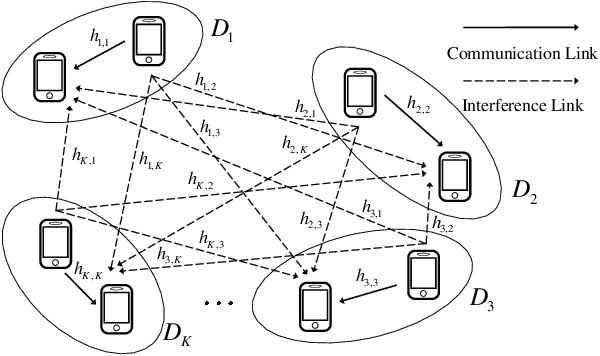
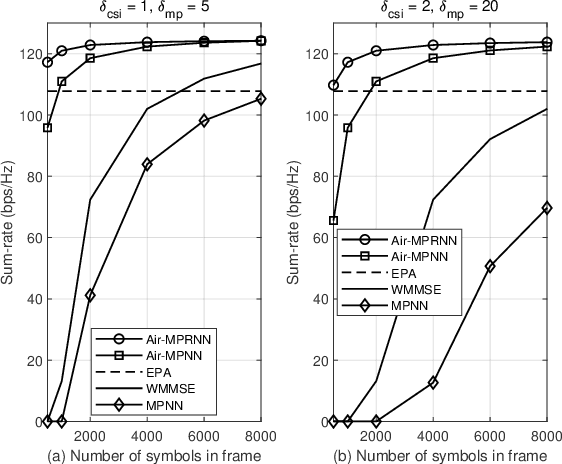
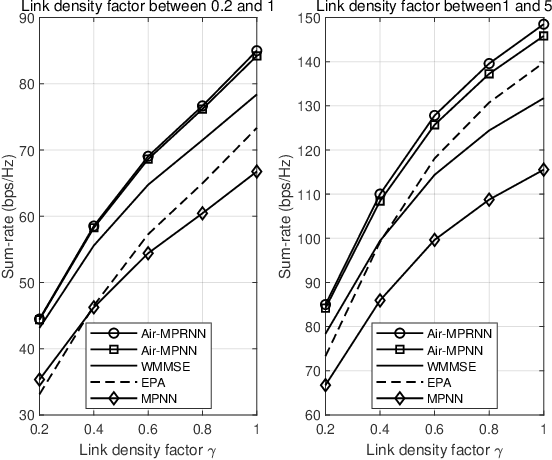

Abstract:Distributed power allocation is important for interference-limited wireless networks with dense transceiver pairs. In this paper, we aim to design low signaling overhead distributed power allocation schemes by using graph neural networks (GNNs), which are scalable to the number of wireless links. We first apply the message passing neural network (MPNN), a unified framework of GNN, to solve the problem. We show that the signaling overhead grows quadratically as the network size increases. Inspired from the over-the-air computation (AirComp), we then propose an Air-MPNN framework, where the messages from neighboring nodes are represented by the transmit power of pilots and can be aggregated efficiently by evaluating the total interference power. The signaling overhead of Air-MPNN grows linearly as the network size increases, and we prove that Air-MPNN is permutation invariant. To further reduce the signaling overhead, we propose the Air message passing recurrent neural network (Air-MPRNN), where each node utilizes the graph embedding and local state in the previous frame to update the graph embedding in the current frame. Since existing communication systems send a pilot during each frame, Air-MPRNN can be integrated into the existing standards by adjusting pilot power. Simulation results validate the scalability of the proposed frameworks, and show that they outperform the existing power allocation algorithms in terms of sum-rate for various system parameters.
Online Cognitive Data Sensing and Processing Optimization in Energy-harvesting Edge Computing Systems
Jun 27, 2021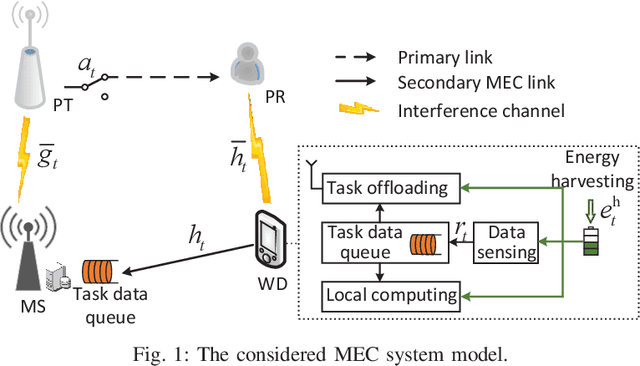
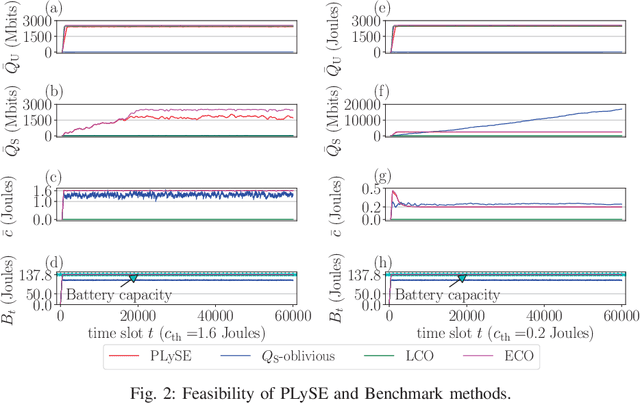
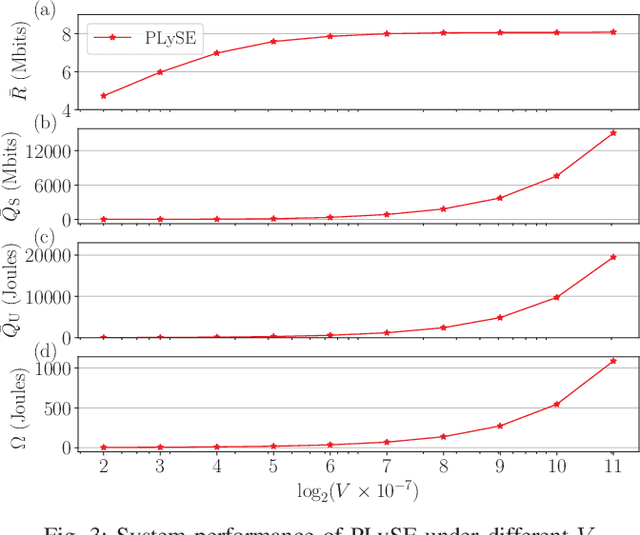
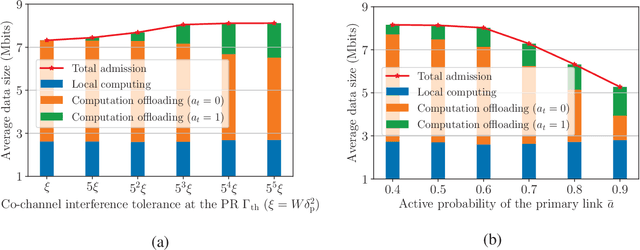
Abstract:Mobile edge computing (MEC) has recently become a prevailing technique to alleviate the intensive computation burden in Internet of Things (IoT) networks. However, the limited device battery capacity and stringent spectrum resource significantly restrict the data processing performance of MEC-enabled IoT networks. To address the two performance limitations, we consider in this paper an MEC-enabled IoT system with an energy harvesting (EH) wireless device (WD) which opportunistically accesses the licensed spectrum of an overlaid primary communication link for task offloading. We aim to maximize the long-term average sensing rate of the WD subject to quality of service (QoS) requirement of primary link, average power constraint of MEC server (MS) and data queue stability of both MS and WD. We formulate the problem as a multi-stage stochastic optimization and propose an online algorithm named PLySE that applies the perturbed Lyapunov optimization technique to decompose the original problem into per-slot deterministic optimization problems. For each per-slot problem, we derive the closed-form optimal solution of data sensing and processing control to facilitate low-complexity real-time implementation. Interestingly, our analysis finds that the optimal solution exhibits an threshold-based structure. Simulation results collaborate with our analysis and demonstrate more than 46.7\% data sensing rate improvement of the proposed PLySE over representative benchmark methods.
 Add to Chrome
Add to Chrome Add to Firefox
Add to Firefox Add to Edge
Add to Edge